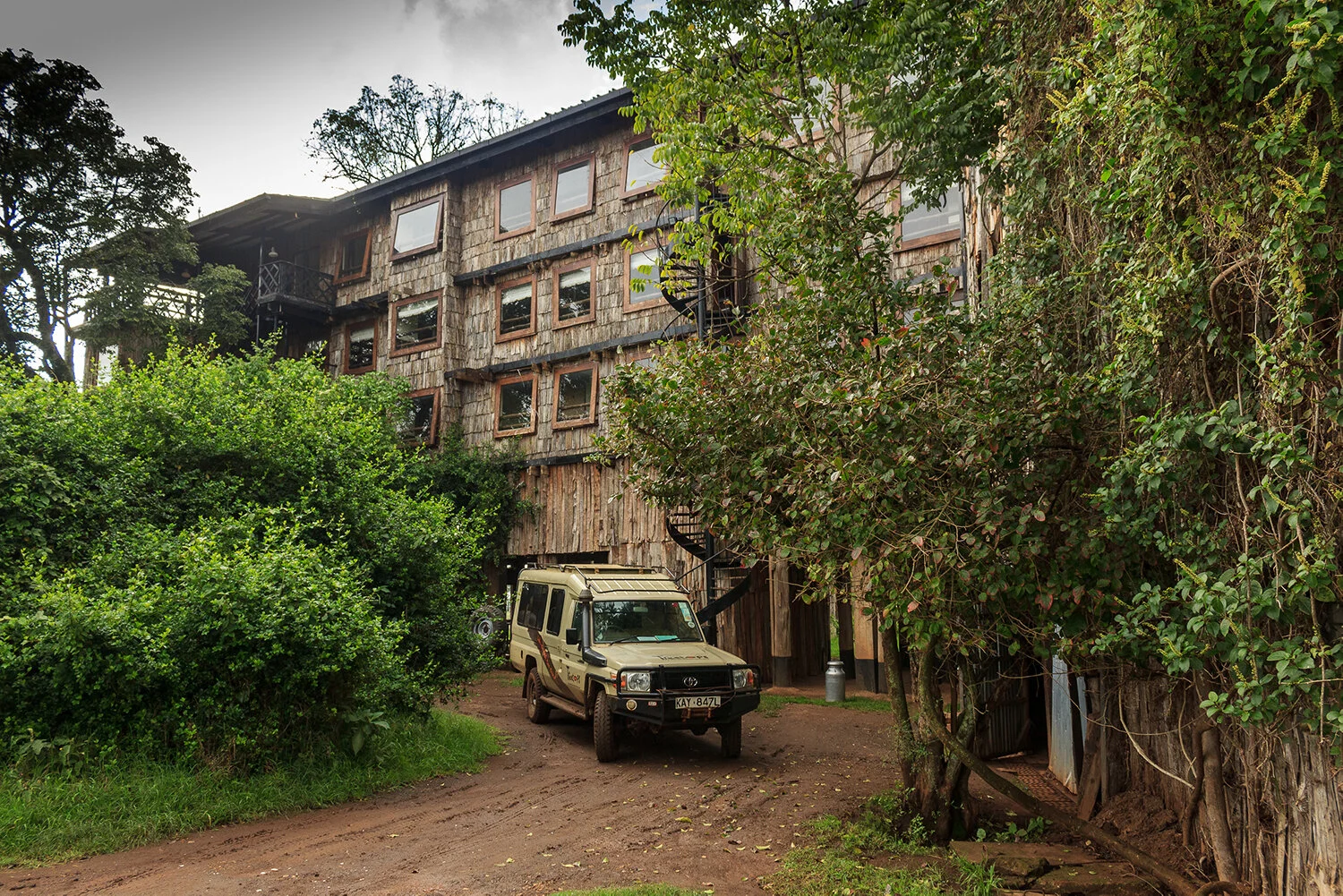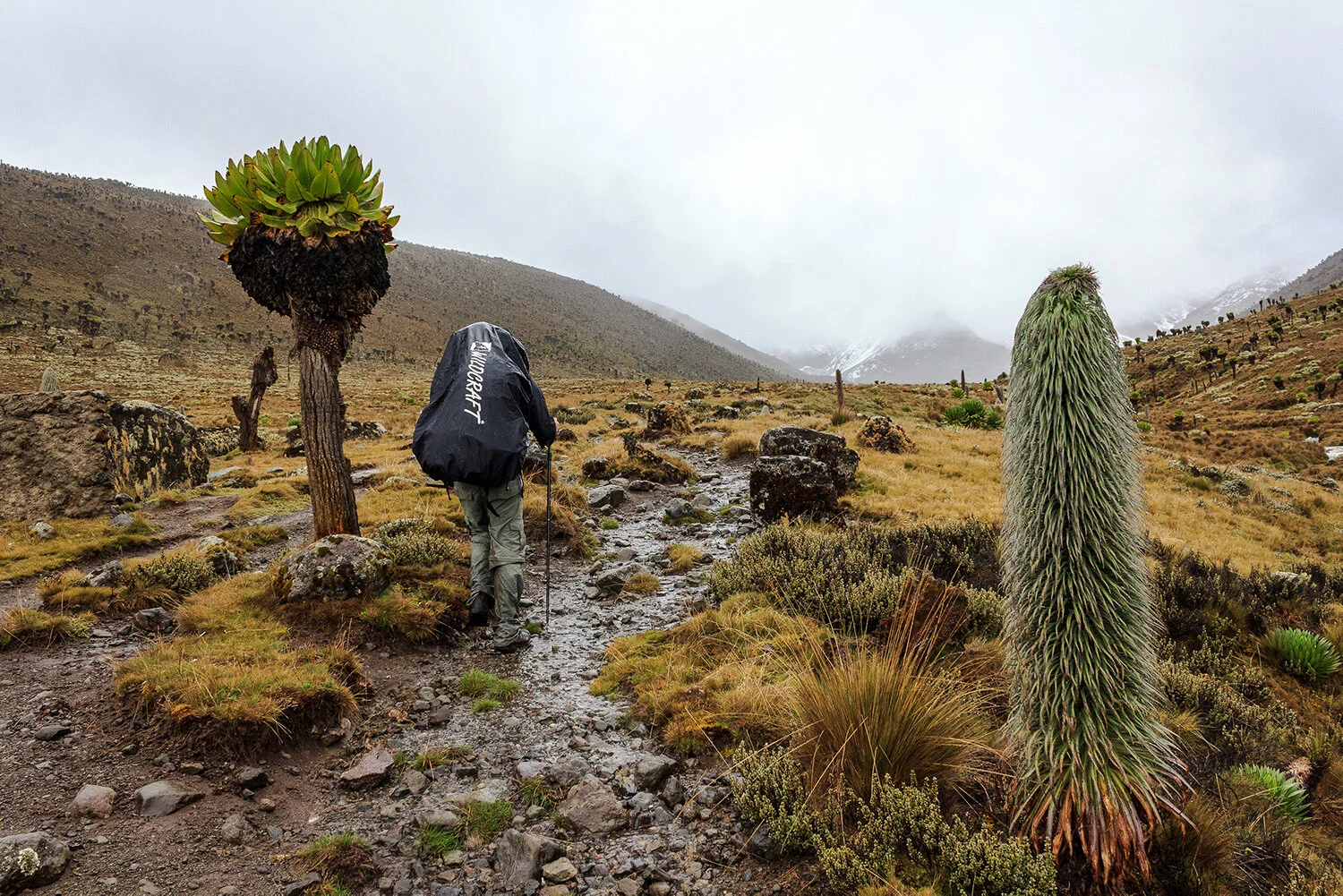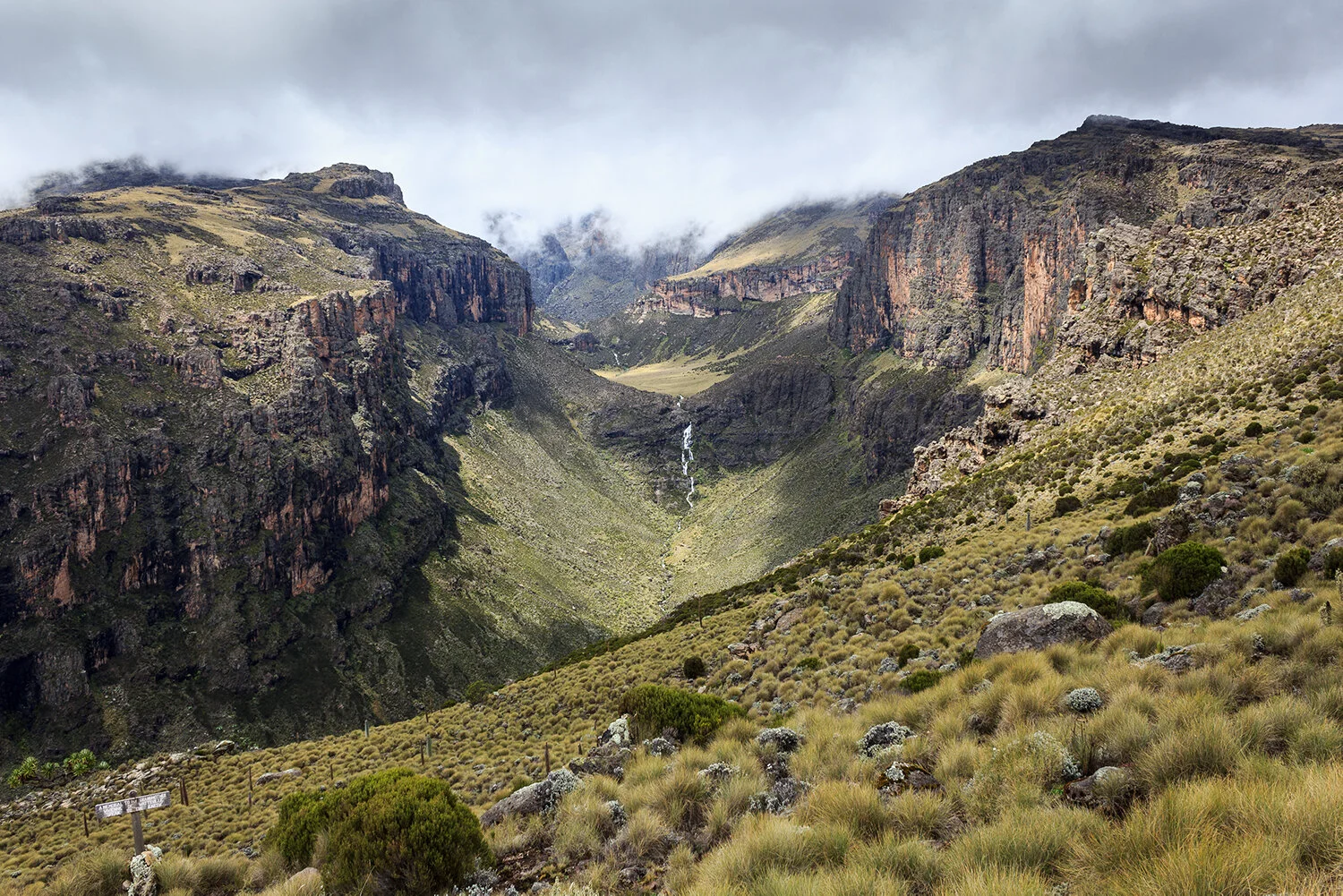
Mount Lenana
- Kenya -
“The best view comes after the hardest climb”
— Alia K.
Figure 1. Tyndall Glacier Retreat. A. 1992, B. 1997 and C. 2002. ©Prinz et al. 2011.
One of the highlights of my stay in Kenya was scaling Mount Kenya or the highest peak in Kenya and the second-highest peak in Africa after Kilimanjaro. The mountain is located east of the Great Rift Valley, about 175km from Nairobi and is one of the few places in the world to have glaciers at the equator. Mount Kenya is a stratovolcano in its geologic origin, which was created about three million years ago after the opening of the Great Rift Valley. Initially, the mountain reached an altitude above 6000m, but due to a heavy glaciation, which lasted for thousands of years, the volcano has been eroded resulting in numerous eroded slopes and a multitude of imposing spires, cliffs, complex ridges and peaks radiating from the centre. Eleven small glaciers are remaining on the mountain, but these are receding fast due to climate change. Recent predictions made by the Intergovernmental Panel on Climate Change suggested that the equatorial glaciers of Mount Kenya would completely disappear by 2050. Since Mount Kenya is an important water tower in the country, which produces about 50% of the country’s freshwater and 70% of its hydroelectric power, the future of water security in the country remains questionable. For this reason, the application of sustainable and renewable initiatives such as hydroponics, geothermal and solar energy must be encouraged since there is such a huge potential for these technologies in Kenya. The country lies at the equator, where the highest incidence of solar radiation on the planet exists, making solar energy probably the best option along with harvesting the geothermal energy from the Rift valley to securing Kenya’s energy.
Figure 2. Eastern side of Mountain Kenya. ©Sergiu Jiduc, 2014
Several vegetation bands descent from peak to base with many endemic species of plants and animals such as the giant lobelias and specious and a local subspecies of rock hyrax. An area of 715km2 around the mountain has been designated a national park in 1949 and a UNESCO World Heritage Site in 1997. In terms of people, several ethnic groups are inhabiting the slopes of the mountain including the Embu, Ameru Kikuyu and the famous Maasai. Some of these tribes believe the mountain to be sacred and used to build their houses facing the mountain, with the doors on the side nearest to it. Around the base of the mountain is fertile farmland. The tribes living around the mountain have cultivated this cool and relatively humid area for centuries with potatoes, coffee and tea being the most popular crops.
The main summits are the twins Batian (5199m) and Nelion (5188m), and these can only be reached utilizing technical climbing via a variety of rock or ice routes. The third highest peak, Point Lenana (4985m) is a popular destination for advanced trekking parties. Point John (4883m) and some of the other subsidiary peaks also offer good rock-climbing routes. The majority of these rock gendarmes are composed of syenite, a rough rock, which is perfect for climbing.
Crossing Mount Kenya from West to East
Figure 3. Our ‘ride’ to the gates of Mount Kenya. ©Sergiu Jiduc, 2014
Our adventure started at the Tea Room Matatu stand, located in central Nairobi. Henrik Huber (a chap from Denmark currently doing an internship at Growth Africa Business Incubation Centre) and I met in the rather chaotic bus station where Nairobians depart to various destinations across the country. Our destination was Naro Moru, located at the base of the western slopes of Mount Kenya, some 170km from Nairobi. Fully packed with camping, trekking and cooking equipment, we carefully negotiated the large crowds of people and chose a matatu, that looked safe, although safe is probably not a common characteristic of these wrecked public transportation means.
Figure 4. Buffalo visits our camp. ©Sergiu Jiduc, 2014
The journey from Nairobi to Naro Moru took us a long three and a half hours on the wild tarmac roads of Kenya. Being cramped in the small seven-setter vehicle with six other people, not including Henrik, was a rather unpleasant experience. Nevertheless, we got through it safe and sound and reached Naro Moru just before the torrential rain started pouring all over the area. Naro Moru is a small market town, lying on the Naro Moru River, between Nyeri and Nanyuki. The main industry of the settlement is a tourism and is one of the main bases for hikers ascending Mount Kenya, to the east. Here we rented some equipment and rented a 4x4 Land Rover vehicle from the Kenya Wildlife Service to take us to the park gate, situated 17km away from Naro Moru. To our surprise, the driver of the Land Rover was the one and only Kim, who accompanied us several days ago to Aberdare National Park, situated not far from Mount Kenya. We were all quite happy to find out that destiny has brought us together again. I knew we were on safe hands with Kim after witnessing his superb driving skills on the terrible dirt tracks of Aberdare’s. Kim drove us to pass the park gate (2400m), through a splendid forest for another 9km until we reached the Meteorological Station (3050m), the road ahead for vehicles.
We camped near the edge of the forest in open grassland for the night. Several buffalos were rather intrigued by our presence in their area but did not dare to approach us and continued to graze peacefully. Dinner was a great feast in this wild environment and consisted of noodle soup and chorizo, pesto pasta. The night was very sinister due to the numerous sounds that were coming from the forest, the majority of them I was not familiar with.
Figure 5. Teleki Valley. ©Sergiu Jiduc, 2014
The next day we left the Meteorological Station early in the morning and continued through the forest until we reached the swampy, muddy section of the route known as the Vertical Bog. As soon as we reached this unpleasant section, the rain began, which continued without stopping for the rest of the day. The ascent via the Teleki Valley to Mackinder hut (4300m) in this humid environment was quite unpleasant, and occasionally, while crossing the Naro Moru stream, it felt like swimming rather than climbing. It is fair to say that when we reached Mackinder’s hut, some six hours after leaving the Met Station, we were soaking wet. Everything was wet including our clothes and sleeping bag inside the rucksack.
For hours we tried to make a fire inside the fireplace of the hut, but unfortunately, the wet logs proved to be quite an inefficient fuel. Eventually, our efforts paid off and the fire kick-started, allowing us to warm up and dry our clothes. Two park rangers paid us a visit in the evening and charged us a decent fare for using the basic facilities of the hut. Dinner and bed came early that night as we had a big ascent very early the next morning.
Figure 6. Batian and Nelion, the technical peaks of Mount Kenya. ©Sergiu Jiduc, 2014
We left Mackinder hut at about 4 am and begun negotiating the confusing paths of Teleki Valley. Fortunately walking in the early morning was pleasant as the boggy areas were frozen. The route took us to the Ranger’s Post with a radio mast beside it, from which it diverged. There were at least three routes that led to the top of Point Lenana, the fastest of which, we hoped to follow. This proved to be a rather difficult mission as the paths were not clear, there were no markers, and my colleague, Henrik left his light torch in Nairobi, which made our ascent quite difficult in the pitch black of the night. After wondering for two hours in the boggy terrain, terminal moraines and other periglacial features, we finally found the correct path that led to Top Hut also known as Austrian Hut (4790m). We made a small detour, which brought us to some dangerous down climbing, but at last, we were back on track.
Figure 7. Point Lenana (right hand-side). ©Sergiu Jiduc, 2014
The ascent to Top Tarn (4490m), a lake situated some 200m below the snout of Lewis Glacier (the largest glacier on Mount Kenya) was quite tiring due to the steep and unstable character of the scree slope. Moreover, I began to feel stomach sick, which I believe was the result of the chorizo pasta. We reached the Austrian Hut around 9:30 in the morning and had breakfast in this magnificent “nest in the clouds” guarded jaw-dropping rock citadels. We were both tired from carrying the heavy bags up here but too close to the summit to give up. The last 200m to the summit of Point Lenana followed the narrow rocky and icy ridge and was a rather difficult ascent. There was a lot of snow and ice, more than anyone has anticipated, and my stomach situation has worsened to the point that I was loosing fluids every 50 meters.
The weather was not looking good either; snowfall began and soon a complete whiteout engulfed the surrounding rocky peaks. With some rather bizarre energy and stubbornness, we reached the summit eventually but fell asleep on a rock platform near the summit pole. I woke up an hour later, feeling slightly dazed and decided to camp on the summit for the night so that I can rest and heal my gut. Finding a relatively flat surface to pitch the tent proved to be a challenge. We struggled several hours building a flat snow platform on the steep northwestern slope of the mountain until we finally were able to pitch the tent. We went to sleep in the afternoon.









Figure 8. Top of Mount Kenya. ©Sergiu Jiduc, 2014
We woke up just before sunset, but to our surprise, the snowfall stopped, and the sun was shining. What happened remained an enigma for me. It was like a divine spectacle to our eyes. Fantastic cloud formations danced beautifully with the static rock citadels. Alluring colours of red, orange, pink, yellow, blue-purple resulted from the sun setting behind “Point John” enchanted the small audience. I have not seen such a marvellous sunset before in my life, and this entire spectacle was just for us. We were alone with the Great Spirit of Ngai, on the second highest peak in East Africa, at the equator. But I have not felt alone, in fact, I never felt so connected ever before. Mount Kenya has succeeded in resetting my spiritual antenna. We went to sleep rather “high” from this unique experience. Even the bitter cold of the night has not managed to change my positive mood.
Figure 9. Chogoria Route, Mount Kenya. ©Sergiu Jiduc, 2014
Early in the morning, we were woken up by several groups of climbers who passed by our tent on their way to the summit. We packed the tent and descended with some of them towards Chogoria Valley located in the east. The valley is probably the most spectacular approach to the main peaks, with beautiful views into the Gorges Valley. Many waterfalls, steep escarpments, bowled shaped hollows filled with freshwater and bizarre vegetation enchanted our long descent to Chogoria gate. One of the guides we've met hooked us up with a land rover driver who took us to Chogoria village, from which we rented a taxi to take back to Nairobi. It took us four days to climb and descent the mountain. We did not use any porters for this ascent and had minimalistic trekking and camping gear. This ascent was a true success crowned with a spectacular sunset








